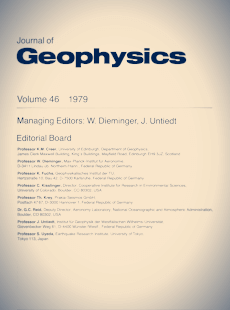Palaeomagnetism and the early magmatic history of Fuerteventura (Canary Islands)
Article Sidebar

Vols. 1-18 (1924-1944), ISSN 0044-2801
Main Article Content
Abstract
Thermal and alternating field demagnetization combined with studies of the convergence points of remagnetization circles have been carried out on a variety of rocks from Fuerteventura. The older (post-Albian) rocks, including the basement plutonics, the sheeted dike complex and the earliest subaerial lava sequence (lava Series I), have a multicomponent remanence while the younger lava Series II of Miocene/Pliocene age has dominantly a one-component magnetization. Comparison of the results with recent palaeomagnetic data from Gran Canaria/Tenerife and with results from continental Africa and Europe suggest a late Cretaceous origin of the basal intrusive rocks while the subaerial volcanism (lava Series I) most likely initiated at around the Cretaceous/Tertiary boundary. This implies that there is a nearly 50-m.y.-long period of volcanic quiescence and erosion between lava Series I and lava Series II. The apparent contradiction between these conclusions and the few K/Ar dates available is discussed.
 ARK: https://n2t.net/ark:/88439/y082688
ARK: https://n2t.net/ark:/88439/y082688
Permalink: https://geophysicsjournal.com/article/281
Article Details
References
Briden, J.C. (1967) A new palaeomagnetic result from the Lower Cretaceous of East Central Africa. Geophys. J. R. Astron. Soc. 12:375-380
El Shazly, E.M., Krs, M. (1973) Palaeogeography and palaeomagnetism of the Nubian Sandstone, Eastern Desert of Egypt. Geol. Rundschau 62:212-225
Fuster, J.A., Cendrero, A., Gastesi, E., Lopez Ruiz, J. (1968) Geologia y volcanologia de las Islas Canarias - Fuerteventura. 239 pp. Madrid: Consejo Sup. Investig. Cient.
Gastesi, P. (1973) Is the Betancuria Massif, Fuerteventura, Canary Islands, an uplifted piece of oceanic crust? Nature Phys. Sci. 246:102-104
Gidskehaug, A., Creer, K.M., Mitchell, J.G. (1975) Palaeomagnetism and K-Ar ages of the South-West African basalts and their bearing on the time of initial rifting of the South Atlantic Ocean. Geophys. J. R. Astron. Soc. 42:9-20
Gouda Hussain, A., Schult, A., Soffel, H. (1979) Palaeomagnetism of the basalts of Wadi Abu Tereifiya, Mandisha and diorite dykes of Wadi Abu Shihat, Egypt. Geophys. J. R. Astron. Soc. 56:55-01
Gough, D.I., Brock, A. (1964) The palaeomagnetism of the Shawa ijolite. J. Geophys. Res. 69:2489-2493
Gough, D.I., Brock, A., Jones, D.L., Opdyke, N.D. (1964) The palaeomagnetism of the ring complexes at Marangudzi and the Mateke Hills. J. Geophys. Res. 69:2499-2507
Gough, D.I., Opdyke, N.D. (1963) The palaeomagnetism of the Lupata Alkaline volcanics. Geophys. J. R. Astron. Soc. 7:457-468
Grunau, H.R., Lehner, P., Cleintuar, M.R., Allenbach, P., Bakker, G. (1975) New radiometric ages and seismic data from Fuerteventura (Canary Islands) and Sao Tome (Gulf of Guinea). In: Progress in Geodynamics. North-Holland Publ. Comp., Amsterdam
Hailwood, E.A., Mitchell, J.G. (1971) Palaeomagnetic and radiometric dating results from Jurassic intrusions in South Morocco. Geophys. J. R. Astron. Soc. 24:351-364
Halls, H.C. (1976) A least-squares method to find a remanence direction from converging remagnetization circles. Geophys. J. R. Astron. Soc. 45:297-304
Halls, H.C. (1978) The use of converging remagnetization circles in palaeomagnetism. Phys. Earth Planet. Inter. 16:1-11
Johansen, O. (1976) Thesis. University of Bergen
Koppen, W., Wegener, A. (1924) Die Klimate der geologischen Vorzeit. Borntraeger, 256 pp. Berlin
McFadden, P.L., Jones, D.L. (1977) The palaeomagnetism of some Upper Cretaceous Kimberlite occurrences. Earth Planet. Sci. Lett. 34:125-135
Robertson, A.H.E., Stillman, C.J. (1979) Late Mesozoic sedimentary rocks of Fuerteventura, Canary Islands: implications for West African continental margin evolution. J. Geol. Soc. London 136:47-60
Rona, P., Nalwalk, A.J. (1970) Post-early Pliocene unconformity of Fuerteventura, Canary Islands. Geol. Soc. Am. Bull. 81:2117-2122
Rothe, P. (1966) Zurn Alter der Vulkanismus auf den ostlichen Kanaren. Soc. Sci. Finnica. Commentar. Phys. Math. Soc. Sci. Fenn. 31(13):1-80
Rothe, P. (1968) Mesozoische Flysch - Ablagerungen auf der Kanarieninsel Fuerteventura. Geol. Rundschau 58:314-322
Schult, A. (1973) Palaeomagnetism of Upper Cretaceous volcanic rocks in Sicily. Earth Plant. Sci. Lett. 19:97-100
Skarnes, A.: Thesis. Bergen: University of Bergen 1977 Stillman, C.J., Fuster, _J.M., Bennell-Baker, M.J., Munoz, M., Smewing, J.D., Sagredo, J. (1975) Basal complex of Fuerteventura (Canary Islands) is an oceanic intrusive complex with rift-system affinities. Nature 257:469-471
Storetvedt, K.M. (1973) The rotation of Iberia; Caenozoic palaeomagnetism from Portugal. Tectonophysics 17:23-39
Storetvedt, K.M. (1978) Structure of remanent magnetization in some Skye lavas, N. W. Scotland. Phys. Earth Planet. Inter. 16:45-58
Storetvedt, K.M., Svalestad, S., Thomassen, K., Langlie, Aa., Nergard, A., Gidskehaug, A. (1978) Magnetic discordance in Gran Canaria/Tenerife and its possible relevance to the formation of the NW. African continental margin. J. Geophys. 44:317-332
Watkins, N.D. (1973) Palaeomagnetism of the Canary Islands and Madeira. Geophys. J. R. Astron. Soc. 32:249-267
Watkins, N.D., Richardson, A., Mason, R.G. (1966) Palaeomagnetism of the Macaronesian insular region: The Canary Islands. Earth Plant. Sci. Lett. 1:225-231











